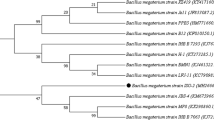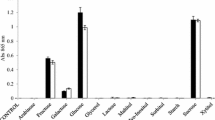Abstract
Molybdenum and heavy metals are toxicants that are needed to be removed from the environment as they are non-biodegradable and pose a serious threat to the ecology. A previously isolated keratin-degrading Bacillus sp. strain khayat was shown to be able to reduce molybdenum (sodium molybdate) to molybdenum blue (Mo-blue). Reduction occurred optimally at the pHs of between 5.8 and 6.8 and temperatures of between 25 and 34 °C. Glucose was the best electron donor for supporting molybdate reduction followed by sucrose, fructose, glycogen, lactose, meso-inositol and glycerol in descending order. Other requirements include a phosphate concentration between 5.0 and 7.5 mM and a molybdate concentration of between 10 and 20 mM. The absorption spectrum of the Mo-blue produced was similar to previous Mo-reducing bacterium, and closely resembles a reduced phosphomolybdate. Molybdenum reduction was inhibited by Hg (ii), Ag (i), Cu (ii), As (v) and Pb (ii) at 84.7, 78.9, 53.5, 36.8 and 27.7 %, respectively. Analysis using phylogenetic analysis resulted in a tentative identification of the bacterium as Bacillus sp. strain khayat. The bacterium was unable utilize any of the xenobiotics as sources of electron donor for reduction but the bacterium was able to grow on diesel and SDS. The ability of this bacterium to detoxify several toxicants makes this bacterium an important tool for bioremediation of multiple toxicants.








Similar content being viewed by others
References
Abo-Shakeer LKA, Ahmad SA, Shukor MY, Shamaan NA, Syed MA (2013) Isolation and characterization of a molybdenum-reducing Bacillus pumilus strain lbna. J Environ Microb Toxicol 1:9–14
Ahmad SA, Shukor MY, Shamaan NA, Mac Cormack WP, Syed MA (2013) Molybdate reduction to molybdenum blue by an antarctic bacterium. BioMed Res Int. doi:10.1155/2013/871941
Ahmad SA, Ahamad KNEK, Johari WLW, Halmi MIE, Shukor MY, Yusof MT (2014) Kinetics of diesel degradation by an acrylamide-degrading bacterium. Rend Fis Acc Lincei 25:505–512
Anu M, Salom Gnana TV, Reshma JK (2010) Simultaneous phenol degradation and chromium (VI) reduction by bacterial isolates. Res J Biotechnol 5:46–49
Asok AK, Jisha MS (2013) Molecular characterization of linear alkylbenzene sulphonate degrading Pseudomonas nitroreducens (MTCC 10463) and P. Aeruginosa (MTCC 10462). Indian J Biotechnol 12:514–522
Bicca FC, Fleck LC, Ayub MAZ (1999) Production of biosurfactant by hydrocarbon degrading Rhodococcus ruber and Rhodococcus erythropolis. Rev Microbiol 30:231–236
Campbell AM, Campillo-Campbell AD, Villaret DB (1985) Molybdate reduction by Escherichia coli K-12 and its chl mutants. Proc Natl Acad Sci 82:227–231
Chaturvedi V, Kumar A (2011) Diversity of culturable sodium dodecyl sulfate (SDS) degrading bacteria isolated from detergent contaminated ponds situated in Varanasi city, India. Int Biodeterior Biodegrade 65:961–971
Chaturvedi V, Kumar A (2013a) Metabolism dependent chemotaxis of Pseudomonas aeruginosa N1 towards anionic detergent sodium dodecyl sulfate. Indian J Microbiol, pp 1–5
Chaturvedi V, Kumar A (2013b) Presence of SDS-degrading enzyme, alkyl sulfatase (SdsA1) is specific to different strains of Pseudomonas aeruginosa. Process Biochem 48:688–693
Chirwa EN, Wang YT (2000) Simultaneous chromium(VI) reduction and phenol degradation in an anaerobic consortium of bacteria. Water Res 34:2376–2384
Chung J, Rittmann BE, Wright WF, Bowman RH (2007) Simultaneous bio-reduction of nitrate, perchlorate, selenate, chromate, arsenate, and dibromochloropropane using a hydrogen-based membrane biofilm reactor. Biodegradation 18:199–209
Cortés-Lorenzo C, Sánchez-Peinado MDM, Oliver-Rodríguez B, Vílchez JL, González-López JJ, Rodríguez-Díaz M (2013) Two novel strains within the family Caulobacteraceae capable of degradation of linear alkylbenzene sulfonates as pure cultures. Int Biodeterior Biodegrad 85:62–65
Dahalan FA, Yunus I, Johari WLW, Shukor MY, Halmi MIE, Shamaan NA, Syed MA (2014) Growth kinetics of a diesel-degrading bacterial strain from petroleum-contaminated soil. J Environ Biol 35:399–406
Dhouib A, Hamad N, Hassaïri I, Sayadi S (2003) Degradation of anionic surfactants by Citrobacter braakii. Process Biochem 38:1245–1250
Diamantino TC, Guilhermino L, Almeida E, Soares AMVM (2000) Toxicity of sodium molybdate and sodium dichromate to Daphnia magna Straus evaluated in acute, chronic and acetylcholinesterase inhibition tests. Ecotoxicol Environ Saf 45:253–259
Ghani B, Takai M, Hisham NZ, Kishimoto N, Ismail AKM, Tano T, Sugio T (1993) Isolation and characterization of a Mo6+-reducing bacterium. Appl Environ Microbiol 59:1176–1180
Ghazali FM, Rahman RNZA, Salleh AB, Basri M (2004) Biodegradation of hydrocarbons in soil by microbial consortium. Int Biodeterior Biodegrad 54:61–67
Glenn JL, Crane FL (1956) Studies on metalloflavoproteins. V. The action of silicomolybdate in the reduction of cytochrome c by aldehyde oxidase. Biochim Biophys Acta 22:111–115
Haley CL, Colmer-Hamood JA, Hamood AN (2012) Characterization of biofilm-like structures formed by Pseudomonas aeruginosa in a synthetic mucus medium. BMC Microbiol, vol 12. doi:10.1186/1471-2180-12-181
Halmi MIE, Hussin WSW, Aqlima A, Syed MA, Ruberto L, MacCormack WP, Shukor MY (2013a) Characterization of a sodium dodecyl sulphate-degrading Pseudomonas sp. strain DRY15 from Antarctic soil. J Environ Biol 34:1077–1082
Halmi MIE, Zuhainis SW, Yusof MT, Shaharuddin NA, Helmi W, Shukor Y, Ahmad SA (2013b) Hexavalent molybdenum reduction to Mo-blue by a sodium-dodecyl-sulfate-degrading Klebsiella oxytoca strain DRY14. BioMed Res Int 2013:e384541. doi:10.1155/2013/384541
Halmi MIE, Shukor MS, Johari WLW, Shukor MY (2014) Modeling the growth curves of Acinetobacter sp. strain DRY12 grown on diesel. J Environ Bioremediat Toxicol 2:33–37
Hori T, Sugiyama M, Himeno S (1988) Direct spectrophotometric determination of sulphate ion based on the formation of a blue molybdosulphate complex. Analyst 113:1639–1642
Ilevbare GO, Burstein GT (2001) The role of alloyed molybdenum in the inhibition of pitting corrosion in stainless steels. Corros Sci 43:485–513
Isa HWM, Johari WLW, Syahir A, Abd. Shukor MY, Nor Azwady AA, Shaharuddin NA, Muskhazli M (2014) Development of a bacterial-based tetrazolium dye (MTT) assay for monitoring of heavy metals. Int J Agric Biol 16:1123–1128
Iyamu EW, Asakura T, Woods GM (2008) A colorimetric microplate assay method for high-throughput analysis of arginase activity in vitro. Anal Biochem 383:332–334
Ke N, Xiao C, Ying Q, Ji S (2003) A new species of the genus Phenylobacterium for the degradation of LAS (linear alkylbenzene sulfonate). Wei Sheng Wu Xue Bao = Acta Microbiol Sin 43:1–7
Khan A, Halmi MIE, Shukor MY (2014) Isolation of Mo-reducing bacterium in soils from Pakistan. J Environ Microbiol Toxicol 2:38–41
Langård S, Lison D, Søstrand P (2012) Chromium, molybdenum, and tungsten. In: Bingham E, Cohrssen B (eds) Patty’s toxicology, vol 1, Chapter 16, 6th edn. Wiley, pp 565–576
Lim HK, Syed MA, Shukor MY (2012) Reduction of molybdate to molybdenum blue by Klebsiella sp. strain hkeem. J Basic Microbiol 52:296–305. doi:10.1002/jobm.201100121
Liwarska-Bizukojc E, Miksch K, Malachowska-Jutsz A, Kalka J (2005) Acute toxicity and genotoxicity of five selected anionic and nonionic surfactants. Chemosphere 58:1249–1253
Losi ME, Frankenberger WTF (1997) Reduction of selenium oxyanions by Enterobacter cloacae strain SLD1a-1: reduction of selenate to selenite. Environ Toxicol Chem 16:1851–1858
Margesin R, Schinner F (1998) Biodegradation of the anionic surfactant sodium dodecyl sulfate at low temperatures. Int Biodeterior Biodegrad 41:139–143
Nasir MFM, Samsudin MS, Mohamad I, Awaluddin MRA, Mansor MA, Juahir H, Ramli N (2011) River water quality modeling using combined principle component analysis (PCA) and multiple linear regressions (MLR): a case study at Klang River, Malaysia. World Appl Sci J 14:73–82
Neunhäuserer C, Berreck M, Insam H (2001) Remediation of soils contaminated with molybdenum using soil amendments and phytoremediation. Water Air Soil Poll 128:85–96
Othman AR, Bakar NA, Halmi MIE, Johari WLW, Ahmad SA, Jirangon H, Shukor MY (2013) Kinetics of molybdenum reduction to molybdenum blue by Bacillus sp. strain A.rzi. BioMed Res Int. doi:10.1155/2013/371058
Payne WJ, Feisal VE (1963) Bacterial utilization of dodecyl sulfate and dodecyl benzene sulfonate. Appl Microbiol 11:339–344
Pettersson A, Adamsson M, Dave G (2000) Toxicity and detoxification of Swedish detergents and softener products. Chemosphere 41:1611–1620
Rahman MFA, Shukor MY, Suhaili Z, Mustafa S, Shamaan NA, Syed MA (2009) Reduction of Mo(VI) by the bacterium Serratia sp. strain DRY5. J Environ Biol 30:65–72
Runnells DD, Kaback DS, Thurman EM, Chappel WR, Peterson KK (1976) Geochemistry and sampling of molybdenum in sediments, soils, and plants in Colorado. In: Molybdenum in the environment. Marcel and Dekker, Inc, New York
Seldén AI, Berg NP, Soderbergh A, Bergstrom EO (2005) Occupational molybdenum exposure and gouty electrician. Occup Med 55:145–148
Shukor MS, Shukor MY (2014) A microplate format for characterizing the growth of molybdenum-reducing bacteria. J Environ Microbiol Toxicol 2:1–3
Shukor MY, Shamaan NA, Syed MA, Lee CH, Karim MIA (2000) Characterization and quantification of molybdenum blue production in Enterobacter cloacae strain 48 using 12-molybdophosphate as the reference compound. Asia Pac J Mol Biol 8:167–172
Shukor MY, Syed MA, Lee CH, Karim MIA, Shamaan NA (2002) A method to distinguish between chemical and enzymatic reduction of molybdenum in Enterobacter cloacae strain 48. Malaysian J Biochem 7:71–72
Shukor MY, Lee CH, Omar I, Karim MIA, Syed MA, Shamaan NA (2003) Isolation and characterization of a molybdenum-reducing enzyme in Enterobacter cloacae strain 48. Pertanika J Sci Technol 11:261–272
Shukor Y, Adam H, Ithnin K, Yunus I, Shamaan NA, Syed A (2007) Molybdate reduction to molybdenum blue in microbe proceeds via a phosphomolybdate intermediate. J Biol Sci 7:1448–1452
Shukor MY, Habib SHM, Rahman MFA, Jirangon H, Abdullah MPA, Shamaan NA, Syed MA (2008a) Hexavalent molybdenum reduction to molybdenum blue by S. marcescens strain Dr. Y6. Applied Biochem Biotech 149:33–43
Shukor MY, Rahman MFA, Shamaan NA, Lee CH, Karim MIA, Syed MA (2008b) An improved enzyme assay for molybdenum-reducing activity in bacteria. Appl Biochem Biotechnol 144:293–300
Shukor MY, Rahman MF, Shamaan NA, Syed MS (2009a) Reduction of molybdate to molybdenum blue by Enterobacter sp. strain Dr.Y13. J Basic Microbiol 49:43–54
Shukor MY, Rahman MF, Suhaili Z, Shamaan NA, Syed MA (2009b) Bacterial reduction of hexavalent molybdenum to molybdenum blue. World J Microbiol Biotechnol 25:1225–1234
Shukor MY, Ahmad SA, Nadzir MMM, Abdullah MP, Shamaan NA, Syed MA (2010a) Molybdate reduction by Pseudomonas sp. strain DRY2. J Appl Microbiol 108:2050–2058
Shukor MY, Rahman MF, Suhaili Z, Shamaan NA, Syed MA (2010b) Hexavalent molybdenum reduction to Mo-blue by Acinetobacter calcoaceticus. Folia Microbiol 55:137–143
Shukor MY, Halmi MIE, Rahman MFA, Shamaan NA, Syed MA (2014) Molybdenum reduction to molybdenum blue in Serratia sp. strain DRY5 is catalyzed by a novel molybdenum-reducing enzyme. BioMed Res Int. doi:10.1155/2014/853084
Sims RPA (1961) Formation of heteropoly blue by some reduction procedures used in the micro-determination of phosphorus. Analyst 86:584–590
Sugiura Y, Hirayama Y (1976) Structural and electronic effects on complex formation of copper(II) and nickel(II) with sulfhydryl-containing peptides. Inorg Chem 15:679–682
Syed MA, Mahamood M, Shukor MY, Shamaan NA (2010) Isolation and characterization of SDS-degrading Pseudomonas aeruginosa sp. strain D1. Aust J Basic Appl Sci 4:5000–5011
Underwood EJ (1979) Environmental sources of heavy metals and their toxicity to man and animals. Prog Water Tech 11:33–45
Yoshimura K, Ishii M, Tarutani T (1986) Microdetermination of phosphate in water by gel-phase colorimetry with molybdenum blue. Anal Chem 58:591–594
Yunus SM, Hamim HM, Anas OM, Aripin SN, Arif SM (2009) Mo (VI) reduction to molybdenum blue by Serratia marcescens strain Dr. Y9. Pol J Microbiol 58:141–147
Zeng GM, Tang L, Shen GL, Huang GH, Niu CG (2004) Determination of trace chromium(VI) by an inhibition-based enzyme biosensor incorporating an electropolymerized aniline membrane and ferrocene as electron transfer mediator. Int J Environ Anal Chem 84:761–774
Acknowledgments
This project was supported by funds from Snoc International Sdn Bhd.
Author information
Authors and Affiliations
Corresponding author
Rights and permissions
About this article
Cite this article
Khayat, M.E., Rahman, M.F.A., Shukor, M.S. et al. Characterization of a molybdenum-reducing Bacillus sp. strain khayat with the ability to grow on SDS and diesel. Rend. Fis. Acc. Lincei 27, 547–556 (2016). https://doi.org/10.1007/s12210-016-0519-5
Received:
Accepted:
Published:
Issue Date:
DOI: https://doi.org/10.1007/s12210-016-0519-5




